 |
Home | Charity | Feedback |
Bhutan:
Bumthang,
Paro,
Phobjikha,
Punakha,
Thimphu
Punakha, Bhutan: Erstwhile Capital by Prakash Bang, Editor in Chief 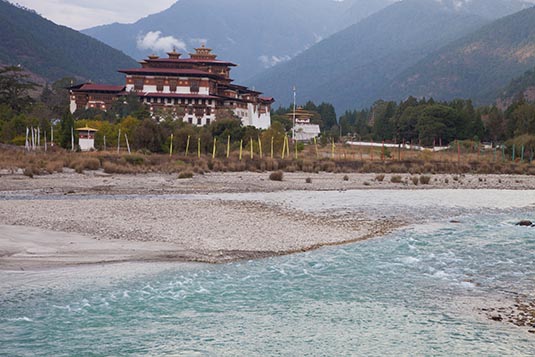 Punakha is the administrative centre of Punakha dzongkhag, one of the 20 districts of Bhutan. Punakha was the capital of Bhutan and the seat of government until 1955, when the capital was moved to Thimphu. Unlike Thimphu it is quite warm in winter and hot in summer. It is located at an elevation of 1,200 metres above sea level and rice is grown as the main crop along the river valleys of two main rivers of Bhutan, the Pho Chu and Mo Chu. 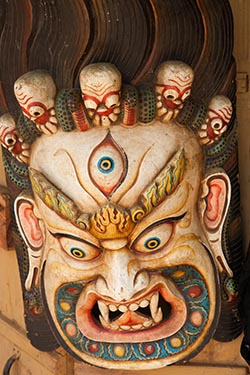 The drive from Thimphu to Punakha can easily take around 3 hours… more if you hit a roadblock. The distance is just about 125 kms. but the hilly section and road works hinder the drive. We were advised by our guide to depart our hotel no later than 8:30 AM. Just outside of Thimphu, a planned roadblock from 10 AM to 2 PM was to happen.
The drive from Thimphu to Punakha can easily take around 3 hours… more if you hit a roadblock. The distance is just about 125 kms. but the hilly section and road works hinder the drive. We were advised by our guide to depart our hotel no later than 8:30 AM. Just outside of Thimphu, a planned roadblock from 10 AM to 2 PM was to happen.
There was a slight drizzle when we left our hotel. The sky was overcast. This was not expected as the skies in December are generally clear. Going by the guide’s experience, we would miss the views of the eastern Himalayan peaks that otherwise are clearly visible from Dochula Pass that’s at 10,000 feet. As we got nearer to Dochula Pass, it had begun to snow. We could see nothing beyond a few metres. Fog was all around. But then that’s the fun of travel… to expect the unexpected. At Dochula Pass we had a cup of our kind of hot tea; not the Bhutanese version that consists of tea, butter & salt – the nation’s favourite brew. Dochula Pass is the location of 108 Stupas or Chortens as locals call them. These chortens were constructed as a memorial built by the queen, Her Majesty Ashi Dorji Wangmo Wangchuk, to honor the victory of the Bhutanese army in the 2003 war of Southern Bhutan. Each one contains effigies of Buddha and religious texts. 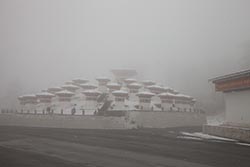 We spent about 45 minutes moving around, taking pictures of snow clad trees… a reminder that Christmas was just round the corner. Our descend began. As we went down, the landscape changed. Paddy fields engulfed the region. In October which is the harvest time, the entire valley turns golden. For now, there were just brown patches.
We spent about 45 minutes moving around, taking pictures of snow clad trees… a reminder that Christmas was just round the corner. Our descend began. As we went down, the landscape changed. Paddy fields engulfed the region. In October which is the harvest time, the entire valley turns golden. For now, there were just brown patches.
Our next stop was Chimi Lhakhang. Our car was parked along the road near Lobesa village. From there it’s about half an hour uphill hike through the village and paddy fields. Chimi Lhakhang is a Buddhist monastery in Punakha District located near Lobesa. It stands on a round hillock and was built in 1499 by the 14th Drukpa hierarch, Ngawang Choegyel, after the site was blessed by the "Divine Madman" the maverick saint Drukpa Kunley (1455–1529) who built a chorten on the site. 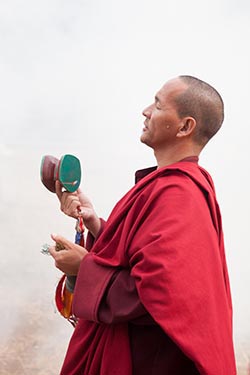 In founding the site it is said that Lama Kunley subdued a demon of Dochu La with his “magic thunderbolt of wisdom” and trapped it in a rock at the location close to where the chorten now stands. He was known as the "Mad Saint" or “Divine Madman” for his unorthodox ways of teaching Buddhism by singing, humour and outrageous behaviour, which amounted to being bizarre, shocking and with sexual overtones. He is also the saint who advocated the use of phallus symbols as paintings on walls and as flying carved wooden phalluses on house tops at four corners of the eves.
In founding the site it is said that Lama Kunley subdued a demon of Dochu La with his “magic thunderbolt of wisdom” and trapped it in a rock at the location close to where the chorten now stands. He was known as the "Mad Saint" or “Divine Madman” for his unorthodox ways of teaching Buddhism by singing, humour and outrageous behaviour, which amounted to being bizarre, shocking and with sexual overtones. He is also the saint who advocated the use of phallus symbols as paintings on walls and as flying carved wooden phalluses on house tops at four corners of the eves.
The monastery is the repository of the original wooden symbol of phallus that Kunley brought from Tibet. This wooden phallus is decorated with a silver handle and is used to bless people who visit the monastery on pilgrimage, particularly women seeking blessings to beget children. The tradition at the monastery is to strike pilgrims on the head with a 10 inch wooden phallus (erect penis). Traditionally symbols of an erect penis in Bhutan have been intended to drive away the evil eye and malicious gossip. 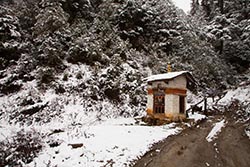 We next moved to Punakha Dzong – the region’s icon.
We next moved to Punakha Dzong – the region’s icon.
The Punakha Dzong, also known as Pungtang Dechen Photrang Dzong (meaning "the palace of great happiness or bliss"), is the administrative centre of Punakha District. Constructed by Ngawang Namgyal, 1st Zhabdrung Rinpoche, in 1637–38, it is the second oldest and second largest dzong in Bhutan and one of its most majestic structures. The dzong houses the sacred relics of the southern Drukpa Lineage of the Kagyu school of Tibetan Buddhism, including the Rangjung Kasarpani and the sacred remains of Ngawang Namgyal and the terton Pema Lingpa. Punakha Dzong was the administrative centre and the seat of the Government of Bhutan until 1955, when the capital was moved to Thimphu. 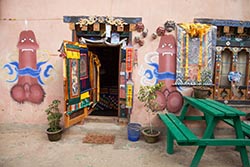 The Dzong is located at the confluence of the Pho Chhu (father) and Mo Chhu (mother) rivers in the Punakha - Wangdue valley. The source of the Mo chu river is in the northern hills of Lighsi and Laya in Bhutan, and in Tibet. The Po Chu River is fed by glaciers in the Lunana region of the Punakha valley. After the confluence of these two rivers, the main river is known as Puna Tsang chu or Sankosh River and flows down through Wangdue Phodrang, crosses the Bhutan - India border at Kalikhola and eventually meets the Brahmaputra River.
The Dzong is located at the confluence of the Pho Chhu (father) and Mo Chhu (mother) rivers in the Punakha - Wangdue valley. The source of the Mo chu river is in the northern hills of Lighsi and Laya in Bhutan, and in Tibet. The Po Chu River is fed by glaciers in the Lunana region of the Punakha valley. After the confluence of these two rivers, the main river is known as Puna Tsang chu or Sankosh River and flows down through Wangdue Phodrang, crosses the Bhutan - India border at Kalikhola and eventually meets the Brahmaputra River.
In view of the healthy climate in the region, Punakha is the winter capital of Bhutan. The head of the clergy of Bhutan with his entourage of monks spend the winter in this dzong. Jacaranda trees grow around the dzong, blooming with mauve flowers in the spring. By 6 PM we were at our hotel – Dhensa Boutique. The location offered great view of the valley. Since it was off-season, we were the only ones around inviting good service! The next morning we would leave for Bumthang. Punakha Image Gallery  Photo viewer Photo viewer
|
|
|
Home |
Charity |
Feedback
Privacy Policy | Terms of Usage © YoGoYo.com. All rights reserved. |





























